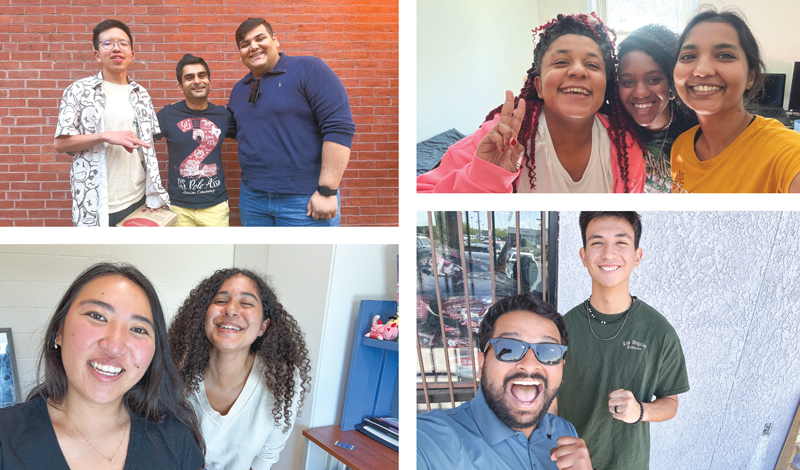SANTA MONICA, Calif.—In early September, SGI-USA youth representatives returned from a training course in Japan, where they discussed with other youth from around the world how to share Buddhism in a new era.
“In our current times, youth are lacking genuine connection,” said Kenichi Hackman, the SGI-USA young men’s leader. He continued that youth around the world struggle with the same challenges. “As youth leaders, our outreach can inadvertently focus more on confirming people to support activities, rather than where it should be, on building genuine relationships.”
What changes need to be made to give youth and leaders the space to build such relationships? This question became the central theme of the third quarterly Central Executive Committee (CEC) Conference, held on Sept. 13, 2025, at the SGI-USA headquarters.
The Executive Council, the highest decision-making body, affirmed the activity guidelines for 2026, setting into motion a series of practical steps to allow more time and space for home visits and personal encouragement as the basis for lasting development.
Adin Strauss elected to a new three-year term.
The CEC opened with the announcement that SGI-USA General Director Adin Strauss had been elected to a third three-year term.
In his opening words, Strauss expressed appreciation to the Executive Council for placing their trust in him and to Ikeda Sensei “for this responsibility and indeed for everything great in my life.”
With the SGI-USA’s focus on helping 10,000 young people receive the Gohonzon and begin their Buddhist practice by Jan. 2, 2028—Sensei’s 100th birthday—Strauss said it was an opportunity to go to a deeper place in his daimoku and practice for others.
“Please join me in daimoku, dialogue and moving to where the members are to make this a reality and fulfill our mentor’s dream—no, his absolute determination—that America would play a central role as the driving force for worldwide kosen-rufu.”
While the CEC members voted to continue developing the three key activity focuses—“shakubuku rooted in friendship,” “strengthening our youth” and “strengthening our district community”—they also agreed to a series of proposals to ensure youth especially have the time to develop genuine friendships.
Shakubuku rooted in friendship.
The CEC members agreed to continue the current focus, led by the youth, to introduce friends to the practice through creating bonds of friendship and trust.
Strengthening our youth.
Last year, men’s and women’s leaders committed to visiting and doing gongyo with their youth division counterparts, which will continue next year.
For future division members, the SGI-USA will develop a more concentrated focus to promote Soka University of America and its mission to foster global citizens at the monthly Soka Family Day meetings.
As for members of the nascent stand-alone student division, they plan to hone their focus next year on establishing and developing 30 campus clubs throughout the country, based on the foundational activities of: campus club meetings; student division-led Buddhist seminars; and exchange meetings with other clubs on campus.
Strengthening our district community.
In December 2010, Ikeda Sensei presented three points to districts toward the Soka Gakkai’s centennial in 2030. They are:
• First, let’s make the joyous chanting of Nam-myoho-renge-kyo resound from our districts.
• Second, let’s bring forth many capable Bodhisattvas of the Earth from our districts.
• Third, let’s raise the banner of victory from our districts. (See Jan. 1, 2011, World Tribune, pp. 4–5.)
In discussing how to strengthen the district community, James Herrmann, the SGI-USA men’s leader, recalled trying to sign up for a membership at a local gym. The salesperson asked where he lived. “He told me not to waste my money,” Herrmann said. “I didn’t live that far away, but he said, statistically, I would not come.”
He used the analogy to underscore the importance of practicing in a district where you live. “It’s not easy to attend a meeting if we need to commute long distances,” he said.
The CEC members voted to:
• focus on enabling members to practice where they live;
• developing groups and group leaders to better serve the members;
• continue helping districts find new and creative discussion meeting formats that create a familylike atmosphere and attract youth;
• continue working toward strong member and guest participation during the milestone months of February, May, August and November; and
• encouraging, wherever possible, that districts chant for 30 minutes to an hour before the discussion meeting as the basis for victory, following the examples of districts from throughout the country.
Flexibility toward activity guidelines.
Based on frontline voices, the CEC members considered ways to streamline activities and provide more time for leaders to visit the members and offer personal encouragement.
With that in mind, they voted to:
• remove the Soka 2030 activity during discussion meeting week to focus more resources on our core monthly activity.
• give local organizations the flexibility to choose a start time for other Soka 2030 meetings (on the morning of the second, fourth and fifth Sunday).
• continue to promote and strengthen the Byakuren, Soka Group and Gajokai youth training groups to support behind the scenes at our Buddhist centers and SGI rental facilities.
Given the challenges involved in adhering to the current guidelines for behind-the-scenes youth support at centers, the CEC body agreed to continue to uphold and challenge themselves to reach these benchmarks, with the awareness that the youth who support activities behind the scenes are crucial to the development of kosen-rufu in America.
“This doesn’t mean that it’s time for the men and women to take everything over,” Strauss cautioned. “The youth are our future.”
Study rooted in the frontlines.
The CEC also voted to add a “3-minute Gosho” presentation to discussion meetings in 2026 to introduce Nichiren Daishonin’s writings to youth in an accessible way. The national youth leaders will prepare a monthly video for presenters; and youth or future division members are encouraged to present, where possible.
Mimi Utsumi, Central Territory leader, recalled helping her own kids present Buddhist parables at district discussion meetings, such as the Jewel in the Robe. “They learned Buddhism in the most genuine and honest way,” she said. “It’s impactful and lasting.”
The CEC members also decided to discontinue region study meetings next year. The focus instead will be on creating dynamic study presentations for the district discussion meeting.
A key component will be encouraging members to both study and bring their SGI-USA publications to the meetings to spark more meaningful dialogues.
Leaders centering discussion meetings are, meanwhile, encouraged to use Ikeda Sensei’s monthly study lecture as the basis for their encouragement.
A focus on enriching, small-group interactions.
The day concluded with guidance by SGI General Director Yoshiki Tanigawa (see p. 8), who shared that the times in the Soka Gakkai’s history when the momentum of shakubuku would suddenly take off had one thing in common: a consistent focus on meeting in small groups, which provides opportunity for more openhearted, informal dialogue.
This means to go beyond looking at the size or organizational level that a discussion meeting is held, he said. “They teach the importance of holding activities and meetings where people can take part in small-group discussions, leaving completely satisfied from their engaging conversations.
“The key to ‘strengthening our district community’ and vibrant growth and advancement will be creating many opportunities for enriching small-group discussions.”
—Prepared by the World Tribune staff
October 10, 2025 World Tribune, pp. 6–7
You are reading {{ meterCount }} of {{ meterMax }} free premium articles

